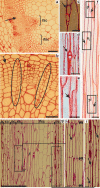Rays, intrusive growth, and storied cambium in the inflorescence stems of Arabidopsis thaliana (L.) Heynh
- PMID: 21311923
- PMCID: PMC3249544
- DOI: 10.1007/s00709-011-0266-5
Rays, intrusive growth, and storied cambium in the inflorescence stems of Arabidopsis thaliana (L.) Heynh
Abstract
Arabidopsis thaliana is a model plant used in analysis of different aspects of plant growth and development. Under suitable conditions, secondary growth takes place in the hypocotyl of Arabidopsis plants, a finding which helps in understanding many aspects of xylogenesis. However, not all developmental processes of secondary tissue can be studied here, as no secondary rays and intrusive growth have been detected in hypocotyl. However, results presented here concerning the secondary growth in inflorescence stems of Arabidopsis shows that both secondary rays and intrusive growth of cambial cells can be detected, and that, in the interfascicular regions, a storied cambium can be developed.
Figures

References
-
- Altamura MM, Possenti M, Matteucci A, Baima S, Ruberti I, Morelli G. Development of the vascular system in the inflorescence stem of Arabidopsis. New Phytol. 2001;151:381–389. doi: 10.1046/j.0028-646x.2001.00188.x. - DOI
-
- Barlow PW. From cambium to early cell differentiation within the secondary vascular system. In: Holbrook NM, Zwieniecki MA, editors. Vascular transport in plants. Amsterdam/New York: Elsevier/Academic; 2005. pp. 279–306.
-
- Busse JS, Evert RF. Pattern of differentiation of the first vascular elements in the embryo and seedling of Arabidopsis thaliana. Int J Plant Sci. 1999;160:1–13. doi: 10.1086/314098. - DOI
MeSH terms
LinkOut - more resources
Full Text Sources

